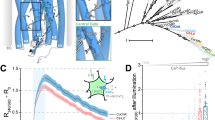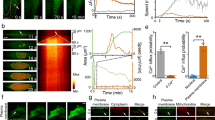Abstract
Calcium (Ca2+) signals that are precisely modulated in space and time mediate a myriad of cellular processes, including contraction, excitation, growth, differentiation and apoptosis1. However, study of Ca2+ responses has been hampered by technological limitations of existing Ca2+-modulating tools. Here we present OptoSTIM1, an optogenetic tool for manipulating intracellular Ca2+ levels through activation of Ca2+-selective endogenous Ca2+ release−activated Ca2+ (CRAC) channels. Using OptoSTIM1, which combines a plant photoreceptor2,3 and the CRAC channel regulator STIM1 (ref. 4), we quantitatively and qualitatively controlled intracellular Ca2+ levels in various biological systems, including zebrafish embryos and human embryonic stem cells. We demonstrate that activating OptoSTIM1 in the CA1 hippocampal region of mice selectively reinforced contextual memory formation. The broad utility of OptoSTIM1 will expand our mechanistic understanding of numerous Ca2+-associated processes and facilitate screening for drug candidates that antagonize Ca2+ signals.
This is a preview of subscription content, access via your institution
Access options
Subscribe to this journal
Receive 12 print issues and online access
$209.00 per year
only $17.42 per issue
Buy this article
- Purchase on Springer Link
- Instant access to full article PDF
Prices may be subject to local taxes which are calculated during checkout



Similar content being viewed by others
References
Berridge, M.J., Lipp, P. & Bootman, M.D. The versatility and universality of calcium signalling. Nat. Rev. Mol. Cell Biol. 1, 11–21 (2000).
Kennedy, M.J. et al. Rapid blue-light-mediated induction of protein interactions in living cells. Nat. Methods 7, 973–975 (2010).
Bugaj, L.J., Choksi, A.T., Mesuda, C.K., Kane, R.S. & Schaffer, D.V. Optogenetic protein clustering and signaling activation in mammalian cells. Nat. Methods 10, 249–252 (2013).
Soboloff, J., Rothberg, B.S., Madesh, M. & Gill, D.L. STIM proteins: dynamic calcium signal transducers. Nat. Rev. Mol. Cell Biol. 13, 549–565 (2012).
Ellis-Davies, G.C.R. Caged compounds: photorelease technology for control of cellular chemistry and physiology. Nat. Methods 4, 619–628 (2007).
Fenno, L., Yizhar, O. & Deisseroth, K. The development and application of optogenetics. Annu. Rev. Neurosci. 34, 389–412 (2011).
Fukuda, N., Matsuda, T. & Nagai, T. Optical control of the Ca2+ concentration in a live specimen with a genetically encoded Ca2+-releasing molecular tool. ACS Chem. Biol. 9, 1197–1203 (2014).
Pham, E., Mils, E. & Truong, K. A synthetic photoactivated protein to generate local or global Ca2+ signals. Chem. Biol. 18, 880–890 (2011).
Korzeniowski, M.K., Manjarrés, I.M., Varnai, P. & Balla, T. Activation of STIM1-Orai1 involves an intramolecular switching mechanism. Sci. Signal. 3, ra82 (2010).
Park, C.Y. et al. STIM1 clusters and activates CRAC channels via direct binding of a cytosolic domain to Orai1. Cell 136, 876–890 (2009).
Zhao, Y. et al. An expanded palette of genetically encoded Ca2+ indicators. Science 333, 1888–1891 (2011).
Liu, H.T. et al. Photoexcited CRY2 interacts with CIB1 to regulate transcription and floral initiation in Arabidopsis. Science 322, 1535–1539 (2008).
Taslimi, A. et al. An optimized optogenetic clustering tool for probing protein interaction and function. Nat. Commun. 5, 4925 (2014).
Hoover, P.J. & Lewis, R.S. Stoichiometric requirements for trapping and gating of Ca2+ release-activated Ca2+ (CRAC) channels by stromal interaction molecule 1 (STIM1). Proc. Natl. Acad. Sci. USA 108, 13299–13304 (2011).
Rothbauer, U. et al. Targeting and tracing antigens in live cells with fluorescent nanobodies. Nat. Methods 3, 887–889 (2006).
Komatsu, T. et al. Organelle-specific, rapid induction of molecular activities and membrane tethering. Nat. Methods 7, 206–208 (2010).
Grigoriev, I. et al. STIM1 is a MT-plus-end-tracking protein involved in remodeling of the ER. Curr. Biol. 18, 177–182 (2008).
Vig, M. et al. CRACM1 multimers form the ion-selective pore of the CRAC channel. Curr. Biol. 16, 2073–2079 (2006).
McNally, B.A., Somasundaram, A., Yamashita, M. & Prakriya, M. Gated regulation of CRAC channel ion selectivity by STIM1. Nature 482, 241–245 (2012).
Tomida, T., Hirose, K., Takizawa, A., Shibasaki, F. & Iino, M. NFAT functions as a working memory of Ca2+ signals in decoding Ca2+ oscillation. EMBO J. 22, 3825–3832 (2003).
Prevarskaya, N., Skryma, R. & Shuba, Y. Calcium in tumor metastasis: new roles for known actors. Nat. Rev. Cancer 11, 609–618 (2011).
Shcherbakova, D.M. & Verkhusha, V.V. Near-infrared fluorescent proteins for multicolor in vivo imaging. Nat. Methods 10, 751–754 (2013).
Riedl, J. et al. Lifeact: a versatile marker to visualize F-actin. Nat. Methods 5, 605–607 (2008).
Muto, A., Ohkura, M., Abe, G., Nakai, J. & Kawakami, K. Real-time visualization of neuronal activity during perception. Curr. Biol. 23, 307–311 (2013).
Apáti, Á. et al. Calcium signaling in pluripotent stem cells. Mol. Cell. Endocrinol. 353, 57–67 (2012).
Wong, R.C., Pébay, A., Nguyen, L.T., Koh, K.L. & Pera, M.F. Presence of functional gap junctions in human embryonic stem cells. Stem Cells 22, 883–889 (2004).
Hooper, R., Rothberg, B.S. & Soboloff, J. Neuronal STIMulation at rest. Sci. Signal. 7, pe18 (2014).
LeDoux, J.E. Emotion circuits in the brain. Annu. Rev. Neurosci. 23, 155–184 (2000).
West, A.E., Griffith, E.C. & Greenberg, M.E. Regulation of transcription factors by neuronal activity. Nat. Rev. Neurosci. 3, 921–931 (2002).
Parekh, A.B. Store-operated CRAC channels: function in health and disease. Nat. Rev. Drug Discov. 9, 399–410 (2010).
Prakriya, M. et al. Orai1 is an essential pore subunit of the CRAC channel. Nature 443, 230–233 (2006).
Gunaydin, L.A. et al. Ultrafast optogenetic control. Nat. Neurosci. 13, 387–392 (2010).
Zhang, F. et al. Multimodal fast optical interrogation of neural circuitry. Nature 446, 633–639 (2007).
Lee, S. et al. Reversible protein inactivation by optogenetic trapping in cells. Nat. Methods 11, 633–636 (2014).
Kaech, S. & Banker, G. Culturing hippocampal neurons. Nat. Protoc. 1, 2406–2415 (2006).
Schmittgen, T.D. & Livak, K.J. Analyzign real-time PCR by the comparative CT method. Nat. Protoc. 3, 1101–1108 (2008).
Chin-Smith, E.C., Slater, D.M., Johnson, M.R. & Tribe, R.M. STIM and Orai isoform expression in pregnant human myometrium: a potential role in calcium signaling during pregnancy. Front. Physiol. 5, 169 (2014).
Goshen, I. et al. Dynamics of retrieval strategies for remote memories. Cell 147, 678–689 (2011).
Tsutajima, J., Kunitake, T., Wakazono, Y. & Takamiya, K. Selective injection system into hippocampus CA1 via monitored theta oscillation. PLoS ONE 8, e83129 (2013).
Kim, N. et al. Spatiotemporal control of fibroblast growth factor receptor signals by blue light. Chem. Biol. 21, 903–912 (2014).
Acknowledgements
We thank C.L. Tucker (University of Colorado) for cDNA encoding CRY2PHR-mCherry, T. Inoue (Johns Hopkins University) for cDNA encoding Tom20-FRB, P. Gardner (Stanford University) for cDNA encoding NFATc1-GFP, D. Lee for fruitful discussions and N. Kim for advice on data analysis. This work was supported by the Institute for Basic Science (IBS-R001-G1), the NRF Stem Cell Program (2011-0019509) funded by MSIP, KAIST Institute for the BioCentury, and the National Leading Research Laboratory Program by the Ministry of Science, ICT and Future Planning (2011-0028772 to Daesoo K.), Republic of Korea.
Author information
Authors and Affiliations
Contributions
W.D.H., T.K. and S.L. conceived the idea and directed the work. T.K., S.L., J.E.K., T.C., Y.-M.J., J.B., A.S., C.-H.K., H.-S.S., Y.-M.H., Daesoo K. and W.D.H. designed experiments; T.K., S.L., J.E.K., T.C., H.P., Y.-M.J., Dongkyu K., S.K., J.B., A.S., J.K., N.Y.K., D.W. and S.C. performed experiments, and T.K., S.L., Daesoo K. and W.D.H. wrote the manuscript.
Corresponding authors
Ethics declarations
Competing interests
The authors declare no competing financial interests.
Supplementary information
Supplementary Text and Figures
Supplementary Figures 1–20 (PDF 6312 kb)
Dynamic movement of OptoSTIM1 along microtubules upon blue-light illumination.
Fluorescent images of HeLa cells expressing OptoSTIM1 were captured at 3.3-s intervals through EGFP channel. Numbers indicate minutes:seconds. (AVI 1088 kb)
Induction of Ca2+ influx by OptoSTIM1 activation.
Fluorescent images of HeLa cells co-expressing R-GECO1 and OptoSTIM1 were captured at 20-s intervals through mCherry and EGFP channels. The movie only represents R-GECO1 signals. Numbers indicate minutes:seconds. (AVI 14467 kb)
Transient or sustained control of Ca2+ influx by pulsatile illumination.
Fluorescent images of HeLa cells co-expressing R-GECO1 and OptoSTIM1 were stimulated by blue light at 10-min (three times) and subsequently at 3-min (ten times) intervals for inducing transient or sustained Ca2+ influx, respectively. The video only represents R-GECO1 signals. Numbers indicate minutes:seconds. (AVI 4386 kb)
Reversible NFATc1 translocation by transient activation of OptoSTIM1.
Fluorescent images of HeLa cells co-expressing NFATc1-mCherry and OptoSTIM1 were captured at 1-min intervals through mCherry channel. Cells were illuminated by blue light for 3 s. The video only represents NFATc1 signals. Numbers indicate minutes:seconds. (AVI 3939 kb)
Reversible disassembly of cortical F-actin by transient activation of OptoSTIM1.
Fluorescent images of HeLa cells co-expressing iRFP670-Lifeact and OptoSTIM1 were captured at 1-min intervals through Alexa-647 and EGFP channels. The video only represents Lifeact signals. Numbers indicate minutes:seconds. (AVI 9204 kb)
Spatiotemporal control of Ca2+ influx in multiple cells upon blue-light illumination.
Fluorescent images of three HeLa cells co-expressing R-GECO1 and OptoSTIM1 were captured at 20-s intervals through mCherry channel. Three cells were sequentially illuminated by blue light (1.5 s) at different time points indicated by arrows. The video only represents R-GECO1 signals. Numbers indicate minutes:seconds. (AVI 3067 kb)
Rights and permissions
About this article
Cite this article
Kyung, T., Lee, S., Kim, J. et al. Optogenetic control of endogenous Ca2+ channels in vivo. Nat Biotechnol 33, 1092–1096 (2015). https://doi.org/10.1038/nbt.3350
Received:
Accepted:
Published:
Issue Date:
DOI: https://doi.org/10.1038/nbt.3350
This article is cited by
-
Photocrosslinking-induced CRAC channel-like Orai1 activation independent of STIM1
Nature Communications (2023)
-
Cardiac optogenetics: shining light on signaling pathways
Pflügers Archiv - European Journal of Physiology (2023)
-
Neuronal Store-Operated Calcium Channels
Molecular Neurobiology (2023)
-
The emergence of molecular systems neuroscience
Molecular Brain (2022)
-
Oscillatory calcium release and sustained store-operated oscillatory calcium signaling prevents differentiation of human oligodendrocyte progenitor cells
Scientific Reports (2022)



